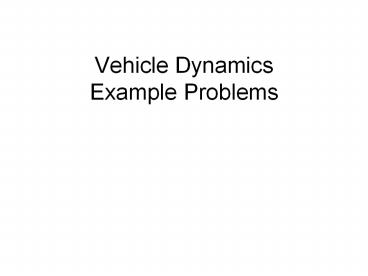Vehicle Dynamics Example Problems PowerPoint PPT Presentation
Title: Vehicle Dynamics Example Problems
1
Vehicle Dynamics Example Problems
2
Example problems
- Calculate value of resistive forces
- Aerodynamic
- Rolling
- Gravity
- Power required to overcome resistive forces
3
Problem 2.1
- A new sports car has a drag coefficient of 0.29
and a frontal area of 20 ft2, and is traveling at
100 mi/h. How much power is required to overcome
aerodynamic drag if ?0.002378 slugs/ft3?
4
Problem 2.2
A vehicle manufacturer is considering an engine
for a new sedan (CD 0.25, Af 17 ft2). The car
will be tested at 100 mph maximum speed on a
concrete paved surface at sea level (? 0.002378
slugs/ft3). The car currently weights 2100 lb,
but the designer selected an under-powered engine
because he did not account for aerodynamic and
rolling resistances. If 2 lb of additional
vehicle weight is added for each unit of
horsepower needed to overcome the neglected
resistance, what will be the final weight of the
car if it is to achieve its 100 mph speed?
5
Balance forces
- Calculate available tractive effort
- Maximum tractive effort
- Engine generated tractive effort
- Acceleration
- Calculate maximum speed
- Available engine power
- Resistive forces
- Maximum speed
6
Problem 2.8
A car is traveling on a paved road with CD
0.35, Af 21 ft2, W 3000 lb, ? 0.002378
slugs/ft3. Its engine is running at 3000 rpm and
is producing 250 ft-lb of torque. The cars gear
reduction ratio is 3.5 to 1, driveline efficiency
is 90, driveline slippage is 3.5, and the
road-wheel radius is 15 inches. What will the
cars maximum acceleration be under these
conditions on a level road? (assume the
available tractive effort is the engine-generated
tractive effort)
7
Problem 2.10
- A 2500-lb car has a maximum speed of 150
miles/hour with 14 inch radius wheels, a gear
reduction of 3 to 1, and a driveline efficiency
of 90. It is known that at the cars top speed
the engine is producing 200 ft-lb of torque. If
the cars frontal area is 25 ft2, what is its
drag coefficient?
8
Braking and stopping
- Braking
- Braking force
- Brake force ratio
- Theoretical stopping distance
- Practical stopping distance
- Driver perception/reaction
9
Problem 2.20
- A driver is traveling at 110 miles/hour down a 3
grade on good, wet pavement. An accident
investigation team noted that braking skid marks
started 590 ft before a parked car was hit at an
estimated 55 mi/h. Ignoring air resistance, and
using theoretical stopping distance, what was the
braking efficiency of the car?
10
Problem 2.23
- A car is traveling at 75 mi/h down a 3 grade on
poor, wet pavement. The cars braking efficiency
is 90. The brakes were applied 300 ft before
impacting a object. The car had an antilock
braking system, but the system failed 200 ft
after the brakes had been applied (wheels
locked). What speed was the car traveling at
just before it impacted the object? (Assume
theoretical stopping distance, ignore air
resistance, and let frl0.015.)

